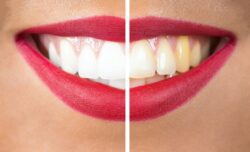Have you noticed that your teeth appear yellow, stained, or otherwise diminished in color? Dental discoloration can impact the way your smile appears. You might suffer a blow to your self-esteem if you feel unhappy with your tooth color.
Your dentist can offer teeth whitening treatment in their office and through a take-home kit that will give you the brighter smile of your dreams. Though highly effective, this treatment will not suit all cases of dental discoloration. Read on to learn more about the teeth whitening treatment your dentist can provide and how it addresses types of tooth stains.

How Do Dentists Brighten Tooth Color?
If you want a brighter smile, a dentist can provide professional-level teeth whitening treatment that you can complete either at their office or at home. The in-office procedure involves a dentist applying a special gel to the teeth. The bleaching ingredients in this product lift stains within the teeth.
Then the dentist can easily wash and scrub them away from the tooth’s surface. They repeat the process until you achieve your ideal tooth color, which takes about one hour in one dental visit.
The take-home whitening kit features custom-made trays that contain this bleaching gel which you wear over your teeth as directed. You can see a gradual brightening in your smile as a result over the course of several weeks.
Which Dental Stains Can Teeth Whitening Remove?
There are several types of dental discoloration, and professional teeth whitening cannot address all kinds of stains in your smile. Surface stains in your tooth enamel can often scrub away with your usual oral hygiene routine.
You can also develop extrinsic stains in your teeth just below the surface of your enamel that a toothbrush cannot reach. These often form due to consuming substances with staining agents like dark-colored foods and drinks or tobacco products.
Teeth whitening can penetrate to access these extrinsic stains and lift them to the surface so that you can get rid of them. However, you may also form deeper dental discoloration known as intrinsic stains.
Bleaching products cannot get to these stains further within the tooth. They form from other factors like medication side effects or aging and therefore will not respond to teeth whitening treatment.
How Can I Whiten My Intrinsic Tooth Stains?
If you have intrinsic stains in your teeth and want a brighter smile, your dentist will need to try other cosmetic dental treatments besides teeth whitening. They can still help you get the smile of your dreams, though they will need to employ alternative methods to accomplish this. The dentist will evaluate your unique dental needs and goals to ensure you find the best treatment for you.
Dentists might recommend tooth bonding or porcelain veneers to cover stubborn tooth stains and enhance their color. They can give you a brighter, natural-looking smile as a result. Consult with your cosmetic dentist to learn more about these smile enhancement solutions.
